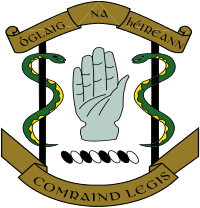Medical Corps (Ireland)
| Irish Army Medical Corps | |
|---|---|
| Irish: An Cór Liachta | |
 | |
| Country |
|
| Branch | Army |
| Type | Medical corps |
| Role | Medical support |
| Part of |
|
| Motto(s) |
Comraind Legis (Middle Irish for "equal division of healing") |
| Insignia | |
| Flag |
.svg.png) |
The Medical Corps (Irish: An Cór Liachta)[1] is the medical corps of the Irish Army, a branch of the Irish Defence Forces, responsible for the provision of health promotion, medical and dental support to forces while on exercise and deployment.
Because it is not a fighting arm (non-combatant), under the Geneva Conventions, members of the corps may only use their weapons for self-defence.
Insignia
The corps has its own distinctive insignia, designed by George Sigerson and TJ McKinney around various symbols of medicine and healing from Irish mythology.[2] Its badge displays the words "Óglaigh na hÉireann" (the name of the Defence Forces in Irish) on a scroll at the top. At the bottom is another scroll with the corps' motto, "Comraind Legis". This Middle Irish phrase is a quotation from the Táin Bó Cuailgne, and is equivalent to modern Irish "comhroinn leighis"; it translates as "equal division of healing", referring to the impartial treatment of the wounded that the main characters of the Táin gave to each other in nocturnal truces between battles.[2]
In the centre is a silver hand, referring to Nuada Airgetlám, the mythological chieftain of the Tuatha Dé Danann who lost his hand in battle and had an artificial silver hand made to replace it, designed by Dian Cecht, the god of healing.[2][3]
The scrolls are joined on each side by a staff about which a serpent is entwined. These do not represent the rod of Aesculapius (the Graeco-Roman mythological symbol of medicine), but rather the staff of Moses. They refers to the legend that the ancestor of the Gaels, Goídel Glas, and his people encountered the Israelites in the desert while the Israelites were suffering a plague of vipers. Goídel Glas was bitten by a viper, and Moses used his staff to cure him.[2]
References
- ↑ http://www.military.ie/ie/an-tarm/eagruchan/cor-an-airm/an-cor-liachta/
- 1 2 3 4 Doolin, William (1952). Dublin's Medical Schools: A Biographical Retrospect. Burroughs Wellcome & Co (The Wellcome Foundation). Front matter. ASIN B0007JLUX0. OL 20312812M.
- ↑ http://www.ismm.ie/badge.html
